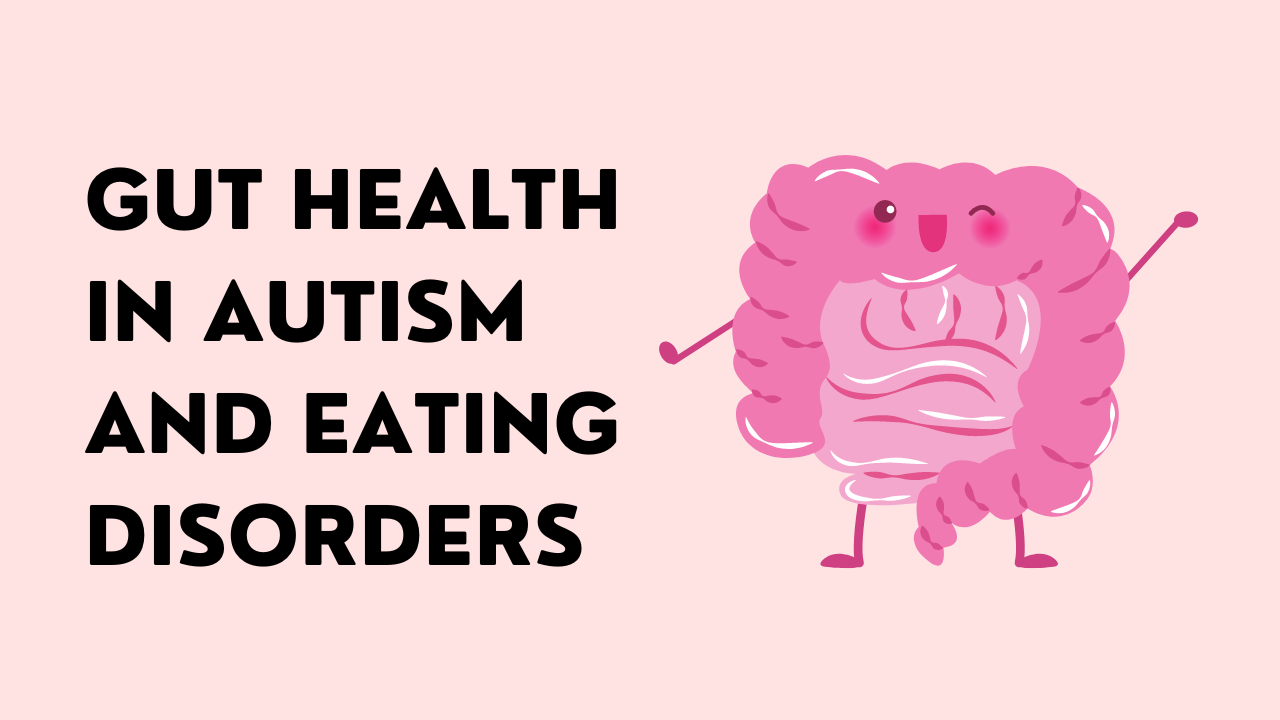Gut Health in Autism and Eating Disorders
Nov 14, 2022
Are you struggling with digestive issues in eating disorder recovery? If so, you are not alone! In fact, functional gastrointestinal disorders (FGIDs) affect up to 98% of people with eating disorders. Suddenly, you’re not that much of an anomaly, huh? But still, knowing you’re not the only one suffering is hardly a solution. Recovery is hard enough as it is – you’re trying to nourish your body, rewire your brain, deprogram yourself from diet culture, and in the midst of all that mental work, you feel like your body is punishing you for eating! But do not fret my friend, because there is a light at the end of the digestive issue tunnel. In this post, I’ll be sharing the scientific relationship between gut issues, autism, and eating disorders, so you can walk away with a newfound understanding of your body and ultimately, take action to heal it.
Gut issues can be particularly tricky for autistic individuals in recovery. Research has linked autism with dysautonomia - disorder of the autonomic nervous system, associated with GI problems like nausea, constipation, bloating, etc. – and this is not even taking eating disorders into account! The brain and the gut are so intimately connected that pretty much any mental distress or disorder – anxiety, depression, OCD, eating disorders - can cause disturbances in the gut. So, if you’re neurodivergent and in recovery, it makes sense that your digestive system is particularly sensitive. But it’s not your fault!
A simple Google search on “gut health” will have you believe otherwise - there is an endless stream of messaging from both medical and alternative health communities that your gut health is a direct reflection of you as a person – your choices, your values, your worth. You’ve probably heard it before: you are what you eat. This is an exceptionally cruel thing to say to someone who is trying to recover from an illness that is rooted in this kind of hypervigilance – every food is a dizzying whirl of numbers, morals, memories, potential “health” consequences. It’s exhausting, and when your gut responds to that stress by becoming even more sensitive, the internet insists it’s because you still haven’t found the “right” diet. It’s easy to feel like psychological healing – changing your beliefs, working through your fears, seeking a kinder and more peaceful relationship with your body – is pointless if you’re still feeling sick all the time.
The Autonomic Nervous System
But there is a growing body of research to suggest that it’s not pointless. Your thoughts matter. Your feelings matter. Your freedom from diet culture matters. Your shame, your stress, your depletion, they all have powerful effects on the gut and nervous system. This is because the communication between your brain and gut is bi-directional. There are afferent (gut-to-brain) pathways which include your intestinal hormones, cytokines (proteins involved in cell signaling), and intestinal microbiota, while efferent (brain-to-gut) pathways are involved in neuroendocrine and autonomic regulation. The autonomic nervous system (ANS) is a network of these afferent and efferent pathways, and is involved with a lot of different functions – heart rate, body temperature, breathing, and digestion, to name a few.
If you’ve read any of my previous posts or are enrolled in my Extreme Hunger Course, you’ve heard me speak of the sympathetic and parasympathetic nervous systems before. To recap, your sympathetic nervous system is your “fight-or-flight” response that gets triggered when your body senses danger. Your parasympathetic nervous system, by contrast, is your “rest-and-digest” mode that turns on when your body perceives safety.
The Polyvagal Theory
Stephen Porges, a psychiatrist and neuroscientist, has a theory called the Polyvagal Theory, which postulates that the ANS is even more complex than just your sympathetic and parasympathetic nervous systems. His theory breaks the ANS down into three circuits: the ventral vagal complex (VVC), the sympathetic nervous system (SNS), and the dorsal vagal complex (DVC). The VVC is the fastest and most metabolically efficient circuit; it slows your heart rate and suppresses the threat-related functions of the SNS and DVC. It is sometimes referred to as the “social engagement nervous system” because it is activated in positive social activities, and has a calming effect.
The SNS is phylogenetically older than the VVC, which means it existed at an earlier stage of human evolution. It innervates structures controlling threat response like your heart, lungs, and sweat glands. Its activation speeds up your heart rate and breathing. It also has connections with your enteric nervous system, which is the web of sensory and motor neurons in your gut. So when it turns on, functions that aren’t immediately essential to survival – like digestion – are put on hold.
The DVC is the oldest circuit; it innervates organs below the diaphragm, so it has direct interaction with your gut. It has been referred to as the “shut-down” circuit, because it’s activated when you face an overwhelming threat that seems impossible to fight or flee from. It conserves metabolic resources, which means, again, digestion is put on hold. That’s why chronic dorsal vagal activity is associated with gastrointestinal problems like slower motility and delayed gastric emptying.
Porges’ research links autism with specific ANS states, like dorsal vagal withdrawal and/or chronic fight-or-flight. However, this research is still new and controversial, as other emerging studies suggest there may be additional factors at play. For example, a study published in 2021 found evidence of greater ANS dysfunction in autistic adults, but this relationship was mediated by higher levels of anxiety. So essentially, what this means is that autistic individuals could experience more symptoms related to certain vagal states, but autism itself may not be the sole cause -- elevated stress due to hypersensitivity could be the linking factor.
The mind-gut connection in eating disorder recovery
All this to say, the brain and the gut are connected in a myriad of ways, and research suggests that automatic state regulation is a key linking factor between the two. Both animal and human studies show correlation between gut inflammation, negative emotional states, and autonomic reactivity. So what does this mean for recovery?
Although our body’s sensitivity to threat seems like something way beyond our control, research shows that mind-body practices like yoga, meditation, and engaging in other relaxing activities can have a healing effect on digestion. Ultimately, you have to prove to your body that it is safe, so that it receives permission to shift into a calm state and thus, promote healthy digestion. I have an entire section in my Extreme Hunger Course all about digestive issues and how to heal them, so if you are not yet enrolled, get your booty (pun intended!) over to my course page!
Another activity that can bring your body into a calm state is spending time with people you love. Several studies have shown that oxytocin receptor signaling involved in interpersonal interactions has direct effects on enteric neurons, which affect gut motility and permeability. Oxytocin (a.k.a. the “love drug”) is a hormone produced in the hypothalamus and released into the bloodstream by the pituitary gland and its primary functions are to induce contractions during childbirth and to stimulate lactation. However, it also plays a key role in relationships. Whether between family, friends, or romantic partners, oxytocin is part of the reason why positive social interactions feel so rewarding – and is another great example of how emotional and physical health are connected.
And that is all I have for you today my friend! If you learned anything from this post or have gotten value from any of my content, it would mean the world to me if you could support me on Patreon. As much as I wish it did, free content doesn't pay the bills. So, for just a few dollars a month, you can make a huge impact in the continuation of all the free value I provide! Click here to donate <3
Sources:
- Ming, Xue, et al. “Respiratory and Autonomic Dysfunction in Children with Autism Spectrum Disorders.” Brain and Development, Elsevier, 30 July 2015, https://www.sciencedirect.com/science/article/abs/pii/S0387760415001345#section-cited-by.
- Kolacz, Jacek, et al. “Traumatic Stress and the Autonomic Brain‐Gut Connection in Development: Polyvagal Theory as an Integrative Framework for Psychosocial and Gastrointestinal Pathology.” Wiley Developmental Psychobiology , Wiley Periodicals, Inc., 23 Feb. 2019, https://integratedlistening.com/wp-content/uploads/2020/10/kolacz-kovacic-and-porges-2019-traumatic-stress-and-the-autonomic-brain-gut-connection-in-development.pdf.
- Bosmans, Goele, et al. “Vagus Nerve Stimulation Dampens Intestinal Inflammation in a Murine Model of Experimental Food Allergy.” NIH National Library of Medicine, John Wiley and Sons Inc., Sept. 2019, https://www.ncbi.nlm.nih.gov/pmc/articles/PMC6790670/.
- De Vries, A, et al. “Immune Dampening Effects of the Vagus Nerve in a Model for Food Allergy.” Clinical and Translational Allergy, BioMed Central, 25 July 2013, https://www.ncbi.nlm.nih.gov/pmc/articles/PMC3723732/.
- Breit, Sigrid, et al. “Vagus Nerve as Modulator of the Brain–Gut Axis in Psychiatric and Inflammatory Disorders.” Frontiers, Frontiers, 13 Mar. 2018, https://www.frontiersin.org/articles/10.3389/fpsyt.2018.00044/full
- Boyd et al., “Psychological Features Are Important Predictors of Functional Gastrointestinal Disorders in Patients with Eating Disorders,” Scandinavian Journal of Gastroenterology 40, no. 8, August 2005: 929-35
- Rosenberg, Stanley. Accessing the Healing Power of the Vagus Nerve: Self-Help Exercises for Anxiety, Depression, Trauma, and Autism. North Atlantic Books, 2017.
- Wasilewska J, Klukowski M. “Gastrointestinal symptoms and autism spectrum disorder: links and risks - a possible new overlap syndrome,” Pediatric Health Med Ther. 28 Sep 2015; 6:153-166. doi: 10.2147/PHMT.S85717. PMID: 29388597; PMCID: PMC5683266.
- Taylor, Emily et. al., “Autonomic dysfunction in autism: The roles of anxiety, depression, and stress,” SAGE Journals, 24 January 2021. https://journals.sagepub.com/doi/full/10.1177/1362361320985658




